I feel sorry for King’s Canyon. Sitting all alone in the back of the Northern Territory of Australia. In the class rankings of Australian travel must-sees, it’s never as popular as the Sydney Opera House, the Great Barrier Reef, or even the less visited but comparatively better known sites like Uluru and Kakadu National Park. King’s Canyon is the Miss Congeniality of Australian travel. In the mix but… you know.
A Miss Congeniality, though, with a wicked temper.
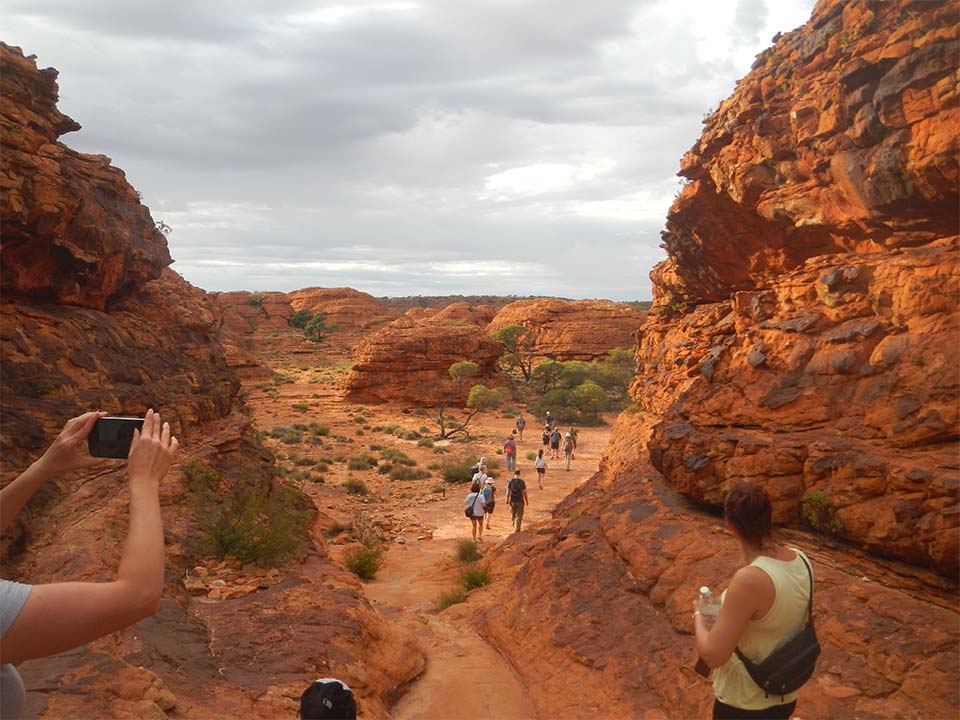
You don’t take the area lightly. Much like Uluru, where we had just wrapped production for that part of The Palette Project, you have to really want to get there. Actually, you have to want to get there even more than you want to get to Uluru. King’s Canyon is always described as being “between Uluru and Alice Springs,” which is kind of like saying Saturn is between Jupiter and Uranus. It is… but pack a lunch.
Uluru, by comparison, is New York City. I mean, the place has its own airport, and the Yulara complex about twelve miles away is the third largest permanently settled area in the Northern Territory. King’s Canyon is 450 Kilometers (almost 300 miles) from Alice Springs… itself pretty remote… via the Lasseter Highway and the turnoff to Red Center Way. The route gets you to King’s Canyon… and very little else. Sure there’s a camel farm where you can sign up for rides, but frankly… and I can’t believe I’m saying this… I’ve seen better.
What I can highly recommend is the roadhouse adjacent to said camel farm, about twenty kilometers south of the canyon. The coffee was good, the dogs on the porch were playful and the muffins were excellent. Really, this is all I ask out of a roadhouse along a forlorn two lane highway in the predawn hours of an outback morning.
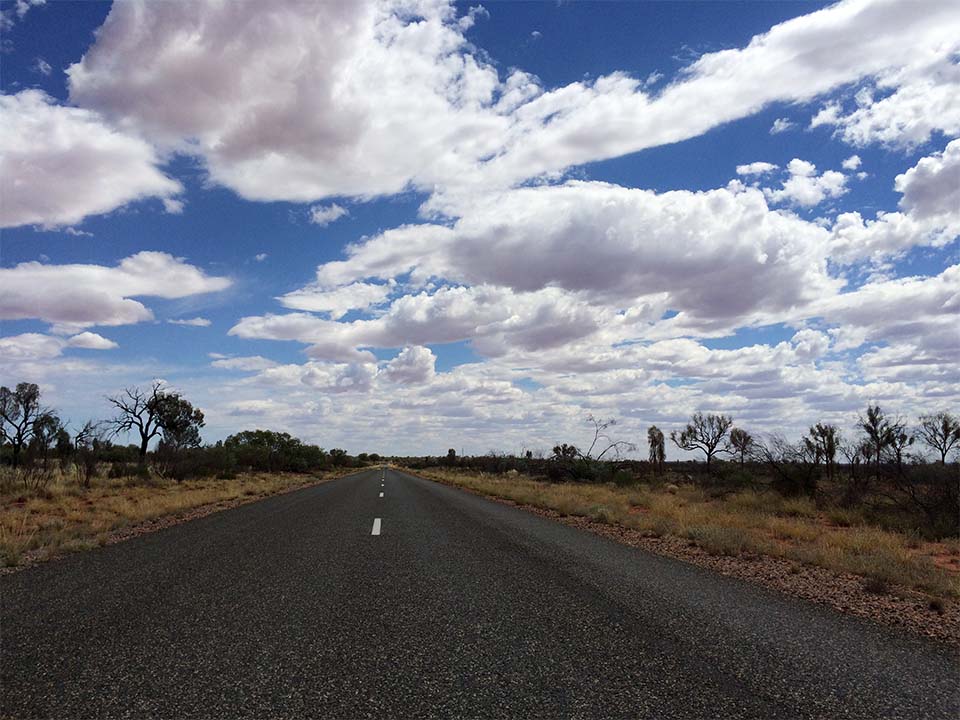
How forlorn? If you take the plunge and head to King’s Canyon, take note of the cars by the side of the road. I use the word “car” loosely because they’r really just the shells of what used to be cars. Lord only knows how long ago they were left here after whatever accidents condemned them to lives of marker points for other travelers and brooding reminders of how not to behave if a road train comes your way. The dry desert air was keeping them from rusting in any serious fashion, but scavengers had long since stripped them of anything valuable as far as spare parts were concerned. Still,you should make a commitment to King’s Canyon. It’s worth your time.
King’s Canyon had been on my filmmaking radar for most of the past year. It was our go-to location if, for some reason, Uluru didn’t pan out for production. For a while, it looked like this “for some reason” may very well happen. Although rangers on the ground at Uluru were enthusiastic about our coming and showing what it was like for a visually impaired filmmaker to experience this sacred site, the powers that be in Canberra had a reputation of being something less than welcoming for film and media crews. Yes, they would gladly take our nonrefundable $500 permit application fee, but we had heard disconcerting stories from organizations as small as an Alice Springs production house and as large as the BBC and National Geographic about the capricious nature of the approval process, not to mention the numerous hoops we would have to jump through to get a permit. If we were traveling almost twelve thousand miles in search of the antipodean representation of Red, we were pretty intent on having a backup plan. King’s Canyon, we felt, would do nicely.
King’s Canyon is managed by the Parks and Wildlife Commission of the NT, not Parks Australia, and the permit process is a lot looser. Our one page permit application and a $45 fee was all it took to get approved in less than a week, and while I would never, never, even if you begged me encourage anyone else to do the following because it would be wrong, I will note for the record that on the day we were shooting at King’s Canyon/Watarrka NP, there were no rangers anywhere in sight, nobody ever asked us for our permit and the only people we saw the entire day were other hikers. So… ahem.. make of that what you will. Me? All I can say is that the folks at Parks and Wildlife were extraordinarily nice, friendly, helpful and if my $45 keeps them on the job, I’m happy to pay it.
If you’re of a mind to have four walls and a ceiling while you’re in the area, you have exactly one option. the King’s Canyon Resort plunks itself down about ten miles from the main King’s Canyon parking lot. Like just about every place we stopped in the outback, the outside is not much to look at. The complex is a bit weather beaten. Inside, however, all is forgiven. The rooms are comfortable, the air conditioning works and the food is good. I really can’t ask for much else, and after five hours on the road, I really didn’t want to anyway. The grocery store on the property has the usual fare and is of course very expensive, but it is the ultimate example of capitalism at work. If you want a Snickers, a can of Pringles or a beet laden veggie burger, you need to consider the fact that it all comes from at least five hundred kilometers away, and usually much further than that. I recommend the Tim Tams.
Actually, I was surprised by how reasonably affordable the food was. Our dinners at both of the on-site restaurants never averaged more than $25 AUD per person and, it being Australia, the beers were plentiful and blessedly cold (I am, of course, not counting the costs of the beer in that $25 total). The sunset viewing area was well worth the stroll and the live music was a treat.
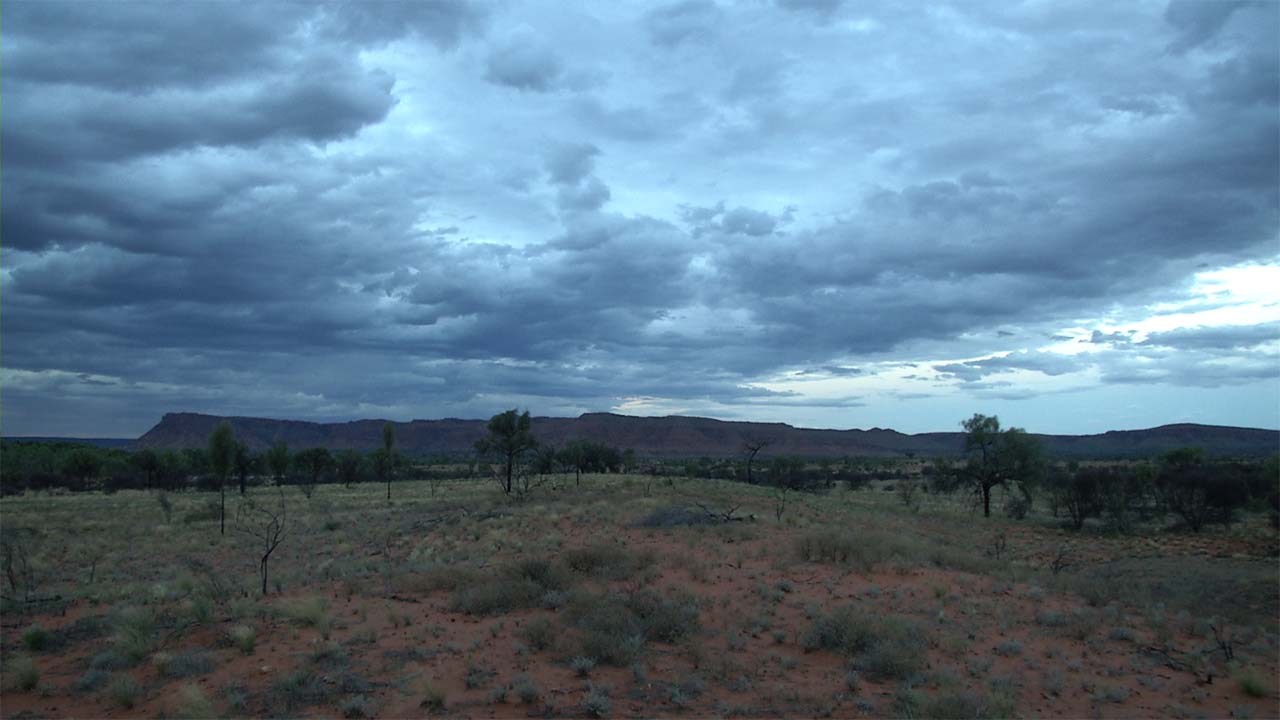
The canyon itself? What I can tell you is my cinematographer and I were very glad we didn’t decide to ditch this shoot once we got a thumbs up from Parks Australia for production at Uluru. King’s Canyon is a jagged schism on the NT landscape, and the best way to see it is to dip into it and around it. It’s a ten mile hike that took us almost six hours to complete, and it was worth every minute
You need to be in good shape to transverse the canyon, and you need to be aware that any canyon hiking you’ve done in the United States will likely not prepare you for what you are about to encounter. I say this as someone who has hiked the Grand Canyon in Arizona both in summer and in winter. The trail is not constructed the same way, for starters. Unlike the log stairs you’ll find along the major trails in the Grand Canyon like Bright Angel and the South Kaibab, King’s Canyon is mostly hewn out of the rock. The “stairs” are steep, unpredictable and can offer very unsure footing. Switchbacks are few and far between. By the end of the trail, you may not be on speaking terms with your knees.
Where King’s Canyon shines, navigation-wise, is in location markers. Much like the trail to Delicate Arch at Arches National Park in Utah, there are way points every few hundred yards, often closer than that and usually within sight of each other where sharp curves in the trail make navigation more difficult. Rangers really do not want you to get lost at King’s Canyon, and have planned these cairns and way points accordingly, and I don’t blame them. On the April morning we tackled the canyon, which is equivalent to October in the northern hemisphere, the temperatures were approaching 36 degrees Celsius (roughly 96 degrees Fahrenheit) by 9 a.m. There are reports of temps reaching almost fifty degrees Celsius in the summer. At temperatures that high, the human body can literally start to cook from within.
Carry water… is what I’m trying to get across.
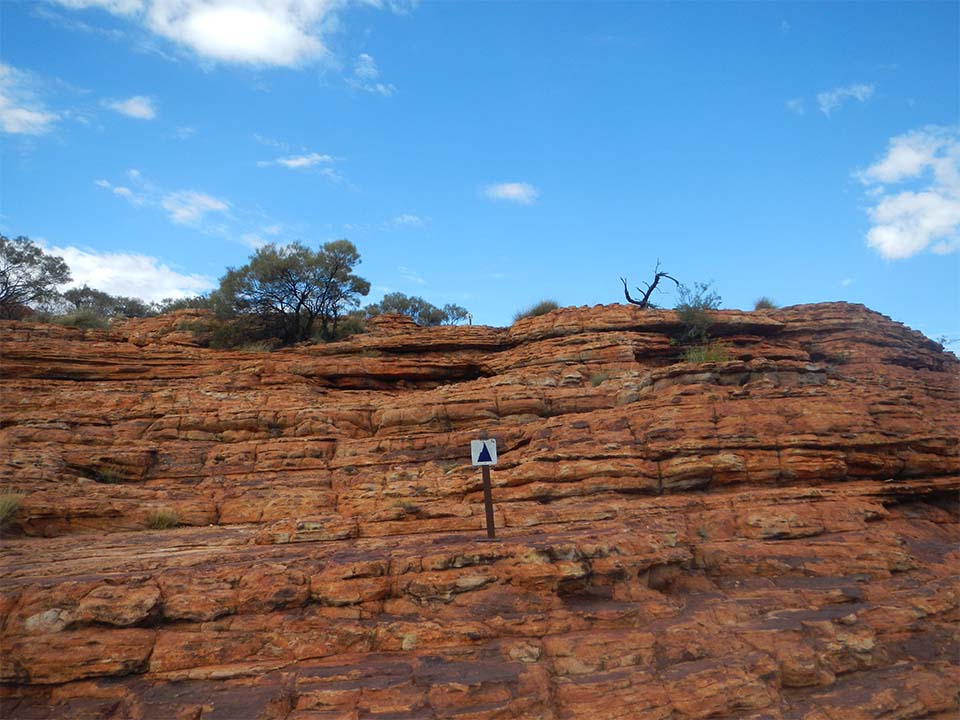
As we did at Uluru, both my cinematographer and I were carrying about six liters of water each. I think we both polished off a liter each in the first kilometer, on an approach to the canyon rim called Heart Attack Hill. It is, I surmise, aptly named. You should be in good shape for this hike, and an uphill climb is not negotiable. You can’t approach the hike from the other direction so that this section is downhill. Hikers are only allowed to hike in one direction, and there’s a self locking gate preventing you from trying on the other end.
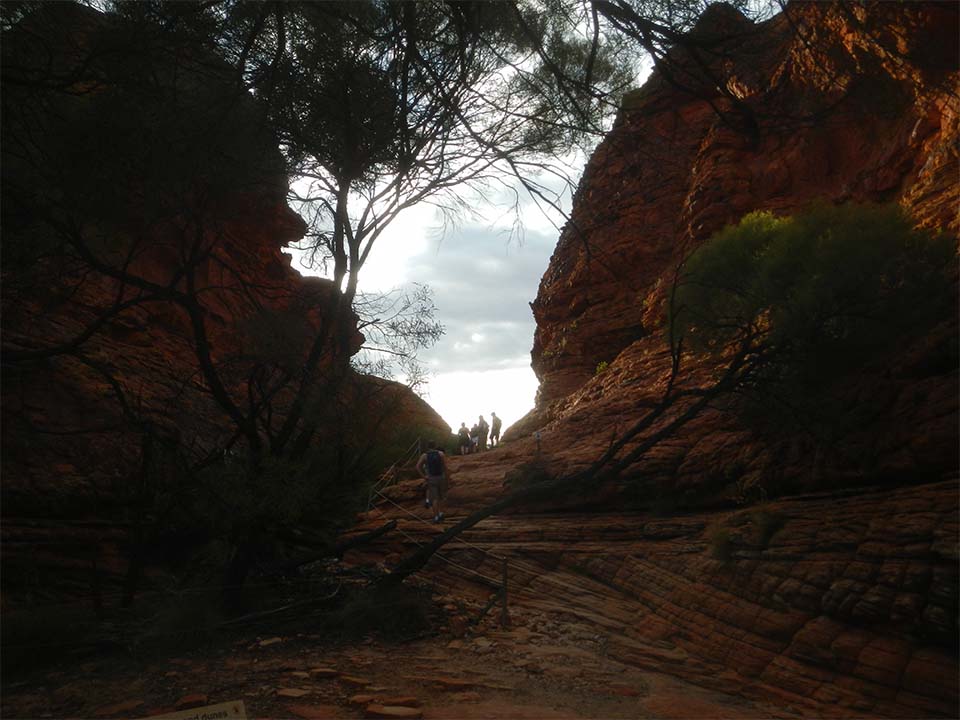
If you hike the canyon, do not, and I mean do not, miss the spur trail that takes you into the very bottom of the canyon. This spur trail terminates at a spot called the Garden of Eden, and every single hiker we encountered coming back from it made sure to tell us how worthwhile it is. As tired as we were (shooting and hiking is never an easy task) we took them at their word and powered through, and they were right on the money. At the river’s edge in this spot, the temperature dropped by nearly ten degrees Celsius. It was cool and breezy and I can report with solid conviction that if we had a tent on us, we might be there still. It’s that nice. It was the first time in almost three weeks that we were not barraged by flies, and I don’t know what it is about the Australian fly but they are just more persistent than any fly anywhere else on earth. On our way back out, we made sure to do our part to convince hikers to take the opportunity to see this spot. It is truly one of the great hidden spots in Australia.
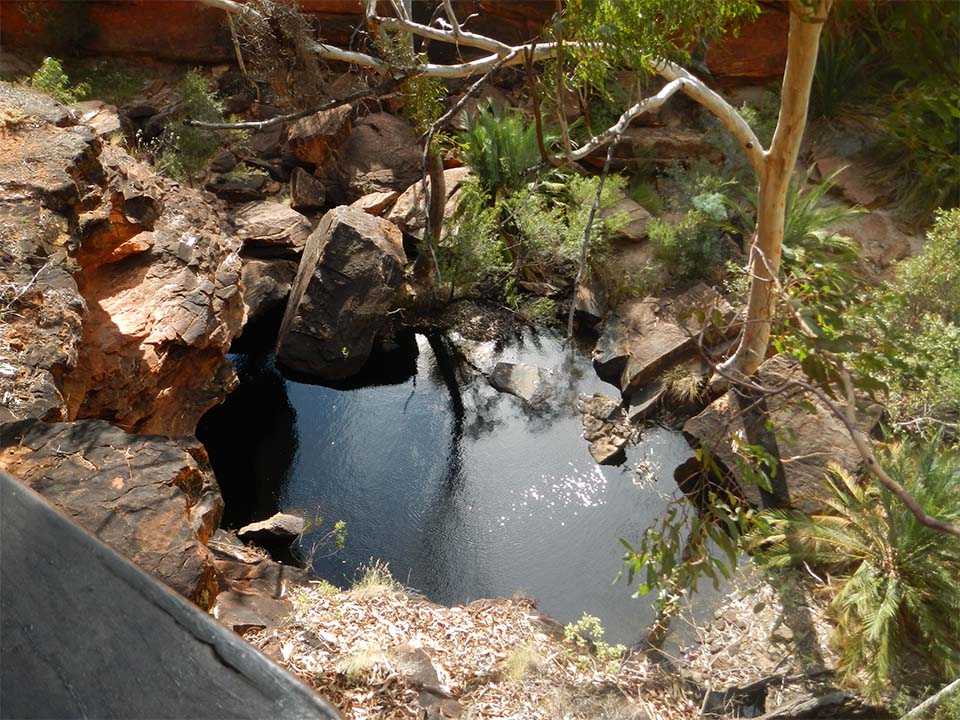
You always feel a bit of pride after hiking something like a canyon. You’ve done something relatively few people do. King’s Canyon makes you work for the reward, but when you’re out, the rush of accomplishment is something that lasts for quite a while. You feel a bit entitled to adopt that faraway look in your eyes… the one that says “I’ve been somewhere you haven’t. I understand something you don’t” A solid, steely yet not quite present look that you would like to be read as one of worldliness.
That doesn’t happen of course. Most people, if they respond at all, say something like “What are you lookin’ at?” But I like it nonetheless.
I’ve left one part of this story out, of course. It’s the part where people on the trail would look at us, then look at me and say “wait, you can’t see? How are you doing this?” Yes, hiking the trail as a visually impaired trekker is not what most people expect. I want to write about this. I’m still figuring it out, and what to say.
Give me a week.
